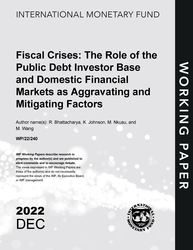
Fiscal Crises: The Role of the Public Debt Investor Base and Domestic Financial Markets as Aggravating and Mitigating Factors
Fiscal Crises: The Role of the Public Debt Investor Base and Domestic Financial Markets as Aggravating and Mitigating Factors
READ MORE...
Volume/Issue:
Volume 2022
Issue 240
Publication date: December 2022
ISBN: 9798400227776
$20.00
Add to Cart by clicking price of the language and format you'd like to purchase
Available Languages and Formats
| English |
Prices in red indicate formats that are not yet available but are forthcoming.
Topics covered in this book
This title contains information about the following subjects.
Click on a subject if you would like to see other titles with the same subjects.
Finance , Economics- Macroeconomics , Public Finance , Economics / General , investor base , crisis data , debt carrying capacity , IV robustness , debt level , Financial sector development , Capital markets , Nonbank financial institutions , Global
Also of interest
Summary
The paper evaluates the key drivers of fiscal crises in a sample of countries from all three income groups—advanced, emerging, and low-income countries, using fiscal crisis data recently developed by the IMF’s Fiscal Affairs Department. The empirical study focuses on three questions: (1) How does the composition of debtholders (domestic vs. foreign, resident vs. non-resident, or official vs. non-official) affect the probability of a fiscal crisis, after controlling for the level of public debt and other relevant variables?; (2) How does the development and size of the domestic financial sector affect the probability of a fiscal crisis?; and (3) How do changes in the debt level affect the probability of a fiscal crisis, for given compositions of the sovereign debt investor base and different levels of development and size of domestic financial markets? Our findings confirm the benefits of financial development, the danger of heavy reliance on a non-resident investor base, and also that emerging market economies have a lower debt carrying capacity compared to the full sample.
Copyright © 2010 - 2025
Powered by:
AIDC



